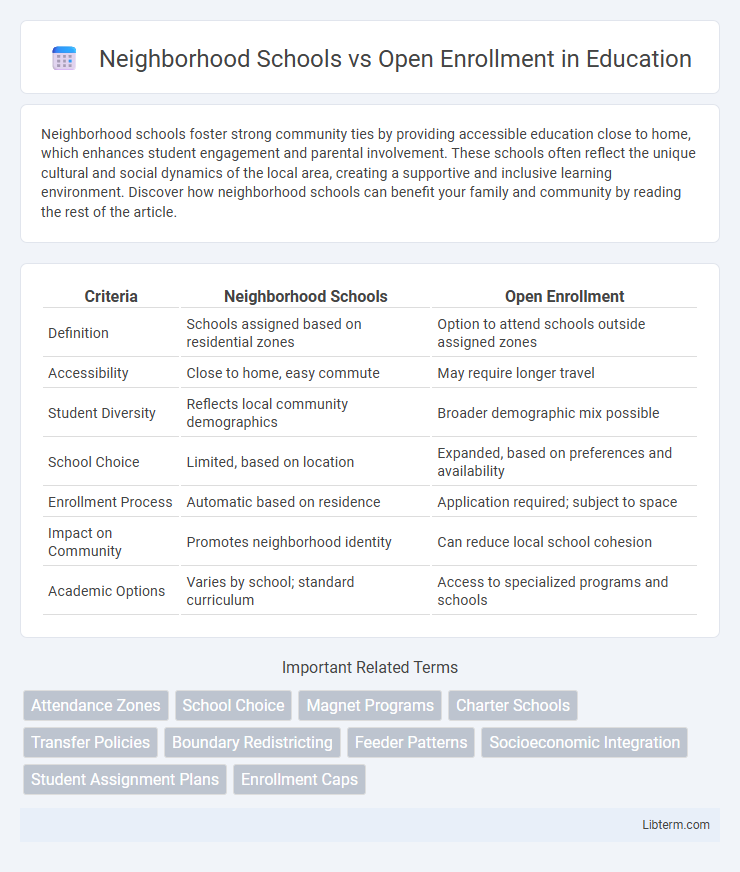Neighborhood schools foster strong community ties by providing accessible education close to home, which enhances student engagement and parental involvement. These schools often reflect the unique cultural and social dynamics of the local area, creating a supportive and inclusive learning environment. Discover how neighborhood schools can benefit your family and community by reading the rest of the article.
Table of Comparison
| Criteria | Neighborhood Schools | Open Enrollment |
|---|---|---|
| Definition | Schools assigned based on residential zones | Option to attend schools outside assigned zones |
| Accessibility | Close to home, easy commute | May require longer travel |
| Student Diversity | Reflects local community demographics | Broader demographic mix possible |
| School Choice | Limited, based on location | Expanded, based on preferences and availability |
| Enrollment Process | Automatic based on residence | Application required; subject to space |
| Impact on Community | Promotes neighborhood identity | Can reduce local school cohesion |
| Academic Options | Varies by school; standard curriculum | Access to specialized programs and schools |
Understanding Neighborhood Schools
Neighborhood schools are public schools assigned based on a student's residential address, fostering strong community ties and local support networks. These schools often reflect the demographic and cultural characteristics of their surrounding areas, contributing to a sense of belonging among students and parents. Understanding the impact of neighborhood schools on educational equity and resource allocation is essential for evaluating local school policies.
What is Open Enrollment?
Open enrollment is a school choice policy allowing students to attend public schools outside their assigned neighborhood zones. This option enables families to select schools based on preference rather than geographic boundaries, promoting access to specialized programs or higher-performing institutions. Open enrollment policies vary by state and district, often requiring application during specific periods and subject to capacity limits.
Key Differences Between Neighborhood Schools and Open Enrollment
Neighborhood schools assign students based on geographic boundaries, ensuring local community engagement and accessibility, while open enrollment allows families to choose schools outside their assigned zones, promoting diversity and specialized program options. Transportation in neighborhood schools is typically provided due to proximity, whereas open enrollment may require families to handle their own transportation logistics. Enrollment policies at neighborhood schools are generally automatic for residents, contrasting with open enrollment's application-based system subject to capacity limits and selection criteria.
Academic Outcomes: Which Model Performs Better?
Neighborhood schools typically demonstrate stronger academic outcomes due to consistent community engagement and localized support systems, which enhance student performance and retention. Open enrollment policies offer students access to specialized programs and diverse educational opportunities, but often face challenges in equitable resource allocation and transportation, potentially impacting academic results. Research indicates that while open enrollment can boost achievement for motivated students, neighborhood schools generally provide more stable and inclusive academic environments conducive to broad student success.
Accessibility and Equity Considerations
Neighborhood schools offer localized access tailored to community demographics, ensuring students attend schools within walking distance which promotes equity by reducing transportation barriers. Open enrollment policies increase accessibility by allowing families to choose schools beyond their zoned area, potentially enhancing educational opportunities but also raising concerns about resource allocation and possible segregation. Balancing these systems requires careful attention to equitable distribution of quality education and transportation infrastructure to support all students fairly.
Impact on School Diversity
Neighborhood schools often reflect the demographic makeup of their immediate geographic area, potentially leading to less diverse student populations in segregated or homogenous communities. Open enrollment policies allow students to attend schools outside their designated zones, promoting increased racial, socioeconomic, and cultural diversity by enabling access to a broader range of educational environments. This flexibility supports more equitable resource distribution and exposure to diverse perspectives, which can enhance social cohesion and educational outcomes.
Transportation and Logistics Challenges
Transportation and logistics challenges play a critical role in the debate between neighborhood schools and open enrollment policies. Neighborhood schools typically offer shorter, more predictable commutes, reducing transportation costs and complexity for districts, while open enrollment can increase transit times and require additional bus routes, escalating operational expenses. Efficient route planning and coordination become more complex with open enrollment, potentially leading to longer travel times for students and increased environmental impacts.
Parental Choice and Community Involvement
Neighborhood schools foster strong community involvement by encouraging parental participation in local events and activities, which enhances social cohesion and investment in student success. Open enrollment policies expand parental choice by allowing families to select schools that best meet their children's educational needs, promoting diversity and innovation within districts. Balancing neighborhood schools with open enrollment options supports both community engagement and individualized education paths for students.
Funding and Resource Allocation Differences
Neighborhood schools primarily receive funding based on local property taxes, resulting in significant disparities in resources between affluent and low-income areas. Open enrollment policies allow students to attend schools outside their designated zones, often channeling funds to more popular or better-performing schools and potentially draining resources from neighborhood schools. This dynamic creates challenges in equitable resource allocation, impacting staffing, facilities, and program availability across districts.
Policy Implications and Future Trends
Neighborhood schools anchor education policy by promoting community cohesion and reducing transportation costs, while open enrollment policies expand parental choice and diversity within districts. Future trends indicate a shift toward hybrid models that balance neighborhood stability with flexible enrollment, impacting funding formulas and equity considerations. Policymakers must address challenges related to resource allocation, student stratification, and infrastructure demands to optimize educational outcomes.
Neighborhood Schools Infographic

 libterm.com
libterm.com